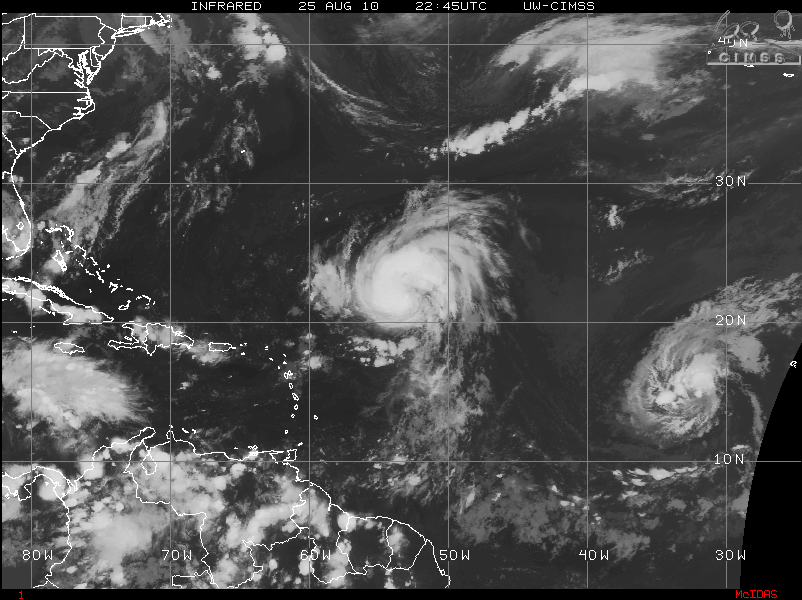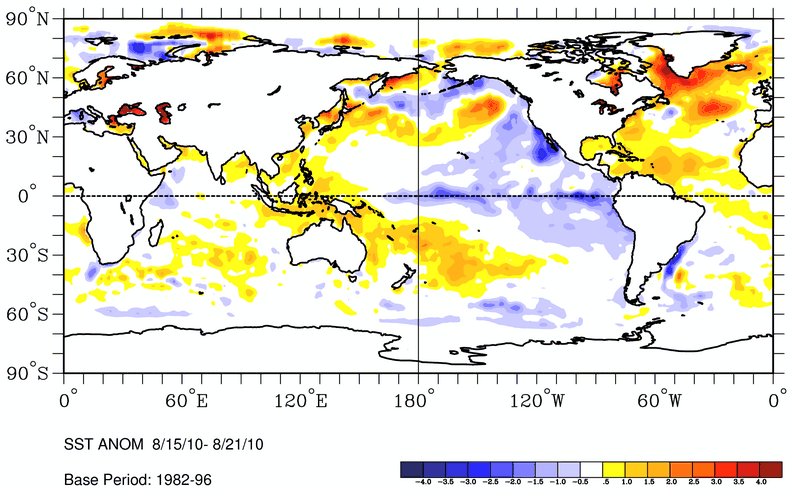08.25.10
Tropical Cyclones: How They Form, Move, and Strengthen (aka, What Danielle, Earl, and Frank Are Up To) – Part 1

Infrared satellite image of Hurricane Danielle and Tropical Storm Earl. Courtesy of CIMSS. Click to enlarge.
Tropical cyclones are large low pressure systems that form in the tropics and obtain their energy from warm ocean waters, as opposed to extratropical cyclones which form over the mid-latitudes and obtain their energy from cold and warm fronts.
To form, tropical cyclones require:
- warm water (at least 80 °F / 27 °C)
- moist air
- instability
- lift
- a lack of wind shear
- some distance from the equator
Tropical cyclones begin with some sort of disturbance near the surface, usually in the form of a tropical/easterly wave, an old frontal boundary, the inter-tropical convergence zone (ITCZ), or the remnants of a previous tropical cyclone.
A tropical (or easterly) wave is a small, low-level, trough of low pressure located in the tropics. Convergence takes place upstream of a trough, while divergence takes place downstream of a trough. Since the trough is in the lower levels of the atmosphere, that upstream convergence occurs near the surface and is where rising air and clouds can be found. Tropical waves are the most common disturbance from which tropical cyclones form.
The ITCZ is a band of converging and rising air near the equator, as a result of northeast winds north of the equator meeting southeast winds south of the equator.
A tropical disturbance must be at least 5 or 10° away from the equator before cyclogenesis can occur. Supercell thunderstorms and tornadoes get their rotation from strong wind shear, while tropical cyclones get their rotation from the Coriolis force. The Coriolis force is an apparent force that is caused by the rotation of the earth, and acts to deflect objects to the right in the northern hemisphere and to the left in the southern hemisphere. You might have heard of this force with relation to the direction water drains down a bathtub. However, this force only takes effect on much larger scales, such as on the scale of a tropical cyclone. The Coriolis force is near zero at the equator and increases poleward, so tropical cyclones cannot form too close to the equator or they will not be able to rotate.
Wind shear is a change of wind speed and/or direction over some distance. Vertical wind shear is a change of wind speed and/or direction (usually we talk about both) over height. As I mentioned above, tropical cyclones do not require wind shear to rotate, unlike tornadoes. In fact, if there is too much wind shear, it will rip a tropical cyclone apart and prevent it from further rotation and organization. A tropical disturbance must remain relatively undisturbed (pardon the pun) for some time before it can develop into a tropical depression (and eventually a tropical storm or hurricane). Weak winds throughout the atmosphere are the best for tropical cyclones.
Once a disturbance is in place over warm, moist waters, in an area lacking wind shear and at least 5 or 10° away from the equator, tropical cyclogenesis may occur.
———————————————-
Currently, Danielle is a Category 1 hurricane in the central Atlantic, starting to move northwestward towards Bermuda. Danielle may become a Category 2 hurricane again by Friday afternoon.
Earl is now the 5th named storm of the Atlantic hurricane season, forming this afternoon in the east Atlantic. Earl will move westward for a while, staying south of Danielle’s track and possibly becoming a hurricane by Friday afternoon.
Frank is a Category 1 hurricane just west of Mexico, but is expected to weaken to a tropical storm by Saturday morning, when he will start recurving back towards Baja California (Frank should only be a minor nuisance by then if he hits the coast).
Sea-surface temperatures are above normal in the neighborhoods of Danielle and Earl, where wind shear is also fairly weak, assisting in the cyclones’ strengthening. Both cyclones have been ingesting some dry air over the ocean, though, which can cause a cyclone to weaken (e.g., Danielle’s sudden weakening to a tropical storm). Frank, although in an area of fairly weak shear, will soon be moving into an area of below normal sea-surface temperatures, forcing him to weaken.
———————————————-
Tomorrow we’ll talk about some of what causes tropical cyclones to move.


World Wide News Flash said,
August 25, 2010 at 10:44 pm
Green Sky Chaser » Tropical Cyclones: How They Form, Move, and ……
I found your entry interesting do I’ve added a Trackback to it on my weblog :)…